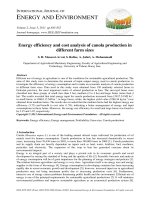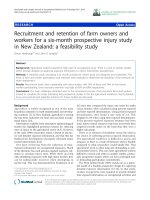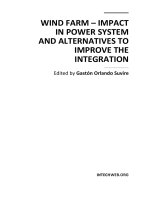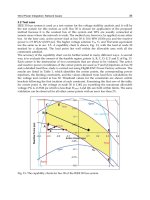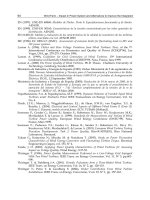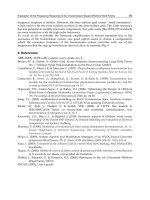Protozoal abortion in farm ruminants
Bạn đang xem bản rút gọn của tài liệu. Xem và tải ngay bản đầy đủ của tài liệu tại đây (3.45 MB, 328 trang )
PROTOZOAL ABORTION IN FARM RUMINANTS:
GUIDELINES FOR DIAGNOSIS AND CONTROL
www.pdfgrip.com
This page intentionally left blank
www.pdfgrip.com
Protozoal Abortion in Farm
Ruminants:
Guidelines for Diagnosis and Control
Edited by
Luis M. Ortega-Mora
Universidad Complutense de Madrid, Departamento de
Sonidad Animal, Ciudad Universitaria, Madrid, Spain
Bruno Gottstein
Institute of Parasitology, University of Bern, Bern, Switzerland
Franz J. Conraths
Friedrich-Loeffler-Institut, Federal Research Institute for Animal
Health, Institute for Epidemiology, Wusterhausen, Germany
and
David Buxton
Moredun Research Institute, Division of Virology, Pentlands
Science Park, Edinburgh, UK
www.pdfgrip.com
CABI is a trading name of CAB International
CABI Head Office
Nosworthy Way
Wallingford
Oxfordshire OX10 8DE
UK
CABI North American Office
875 Massachusetts Avenue
7th Floor
Cambridge, MA 02139
USA
Tel: +44 (0)1491 832111
Fax: +44 (0)1491 833508
E-mail:
Website: www.cabi.org
Tel: +1 617 395 4056
Fax: +1 617 354 6875
E-mail:
© CAB International 2007. All rights reserved. No part of this publication may be
reproduced in any form or by any means, electronically, mechanically, by
photocopying, recording or otherwise, without the prior permission of the copyright
owners.
A catalogue record for this book is available from the British Library, London, UK.
A catalogue record for this book is available from the Library of Congress,
Washington, DC.
ISBN-13: 978 1 84593 211 4
Typeset by Columns Design Ltd, Reading, UK
Printed and bound in the UK by Athenaeum Press, Gateshead
www.pdfgrip.com
Contents
Contributors
vii
Preface
John Williams
xi
Introduction
Luis M. Ortega-Mora, David Buxton, Bruno Gottstein and
Franz J. Conraths
xiii
Acknowledgements
xvii
1. Background to Reproductive Problems in Cattle and Sheep
Rico Thun and Fredi Janett
1.1. Puberty
1.2. Oestrous Cycle
1.3. Pregnancy and Parturition
1.4. The Post-partum Period
1.5. Fertility Problems
1
1
2
4
7
9
2. Sample Collection
2.1. Study Design
Chris Bartels and Franz J. Conraths
2.2. Sample Collection
Gorka Aduriz and Raquel Atxaerandio
16
16
3. Aetiological Diagnosis
3.1. Neosporosis
Franz J. Conraths and Bruno Gottstein
42
42
34
v
www.pdfgrip.com
vi
Contents
3.2.
3.3.
3.4.
Toxoplasmosis
David Buxton and Bertrand Losson
Sarcocystiosis
Anja R. Heckeroth and Astrid M. Tenter
Tritrichomonosis
Heinz Sager, Ignacio Ferre, Klaus Henning and
Luis Ortega-Mora
4. Differential Diagnosis of Protozoal Abortion in Farm
Ruminants
4.1. Non-infectious Causes of Abortion in Farm Ruminants
Michel Hässig
4.2. Infectious Causes
Franz J. Conraths
122
172
232
263
263
264
5. Control Measures
5.1. Neosporosis
Franz J. Conraths, Gereon Schares, Luis M. Ortega-Mora
and Bruno Gottstein
5.2. Toxoplasmosis
David Buxton
5.3. Sarcocystiosis
Franz J. Conraths
5.4. Tritrichomonosis
Carlos M. Campero and Bruno Gottstein
276
276
Index
302
www.pdfgrip.com
284
289
290
Contributors
Dr Gorka Aduriz, Instituto Vasco de Investigación y Desarrollo Agrario
(NEIKER), Departamento de Sanidad Animal, Berreaga 1, 48160 Derio,
Vizcaya, Spain. Tel: +34 94 403 43 00; Fax: +34 94 403 43 10.
Dr Gema Alvarez-García, Universidad Complutense de Madrid, Departamento
de Sanidad Animal, Facultad de Veterinaria, Ciudad Universitaria, 28040
Madrid, Spain. Tel: +34 91 3943844; Fax: +34 91 3943908. gemaga@vet.
ucm.es
Dr Raquel Atxaerandio, Instituto Vasco de Investigación y Desarrollo Agrario
(NEIKER), Departamento de Sanidad Animal, Berreaga 1, 48160 Derio,
Vizcaya, Spain. Tel: +34 94 403 43 00; Fax: +34 94 403 43 10.
Dr Chris Bartels, Animal Health Service, PO Box 9, 7400 AA Deventer, The
Netherlands. ;
Dr Camilla Björkman, National Veterinary Institute and Swedish University
of Agricultural Sciences, Department of Parasitology (SWEPAR), 751 89
Uppsala, Sweden. Tel: +46 18 67 1778; Fax: +46 18 67 3575. camilla.
Dr David Buxton, Moredun Research Institute, Division of Virology, Pentlands
Science Park, Bush Loan, Edinburgh EH26 0PZ, UK. Tel: +44 (0)131 445
5111; Fax : +44 (0)131 445 6111.
Dr Carlos Campero, Instituto Nacional de Tecnología Agropecuaria, C.C. 276(7620), Balcarce, Argentina. Tel: 54–2266–439120; Fax: 54–2266–439101.
Dr Franz J. Conraths, Friedrich-Loeffler-Institut, Federal Research Institute
for Animal Health, Institute for Epidemiology, Seestrasse 55, 16868
vii
www.pdfgrip.com
viii
Contributors
Wusterhausen, Germany. Tel: +49 33 979 80 176; Fax: +49 33 979 80 200.
franz.conraths@fli.bund.de
Dr Thomas Dijkstra, Animal Health Service, PO Box 9, 7400 AA Deventer,
The Netherlands.
Dr Ignacio Ferre Pérez, Universidad Complutense de Madrid, Departamento
de Sanidad Animal, Facultad de Veterinaria, Ciudad Universitaria, 28040
Madrid, Spain. Tel: +34 91 3943844; Fax: +34 91 3943908. iferrepe@
vet.ucm.es
Dr Ana García-Pérez, Instituto Vasco de Investigación y Desarrollo Agrario
(NEIKER), Departamento de Sanidad Animal, Berreaga 1, 48160 Derio,
Vizcaya, Spain. Tel: +34 94 403 43 00; Fax: +34 94 403 43 10. agarcia@
neiker.net
Dr Bruno Gottstein, Institute of Parasitology, University of Bern, Länggasss-Str.
122, 3001 Bern, Switzerland. Tel: +41 31 631 2418; Fax: +41 31 631 2622.
Dr Michael Haessig, University of Zürich, Herd Health, Department of Farm
Animals, Winterthurerstrasse 260, 8057 Zürich, Switzerland. Tel: +41 44 635
82 60; Fax: +41 44 635 89 04.
Dr Anja R. Heckeroth, Intervet Innovation GmbH, Zur Propstei, 55270
Schwabenheim, Germany.
Dr Klaus Henning, Friedrich-Loeffler-Institut, Federal Research Institute for
Animal Health, Institute for Epidemiology, Seestrasse 55, 16868 Wusterhausen,
Germany. Tel: +49 33 979 80 156; Fax: +49 33 979 80 222. Klaus.henning@
fli.bund.de
Dr Ana Hurtado, Instituto Vasco de Investigación y Desarrollo Agrario
(NEIKER), Departamento de Sanidad Animal, Berreaga 1, 48160 Derio,
Vizcaya, Spain. Tel: +34 94 403 43 00; Fax: +34 94 403 43 10. ahurtado@
neiker.net
Dr Elisabeth A. Innes, Moredun Research Institute, Division of Parasitology,
Pentlands Science Park, Bush Loan, Edinburgh EH 26 0PZ. Tel: +44
(0)131 445 5111; Fax: +44 (0)131 445 6111.
Dr Fredi Janett, University of Zürich, Department of Farm Animals,
Winterthurerstrasse 260, 8057 Zürich, Switzerland. Tel: +41 44 63 58218.
Dr Laura Kramer, Dipt. Di Produzione Animale, Facolta di Medicina
Veterinaria, Via del Taglio 8, 43100 Parma, Italy. Tel: +31 0521 902 776;
Fax: +39 0521 902 770.
Dr Bertrand Losson, Faculty of Veterinary Medicine and Parasitology, University
of Liège, BD. DE Colonster, 20 4000 Liège, Belgium. Tel: +32 4 366 4090; Fax:
+32 4 366 4097.
Dr Stephen Maley, Moredun Research Institute, Division of Virology,
Pentlands Science Park, Bush Loan, Edinburgh EH26 0PZ, UK. Tel: +44 131
445 5111; Fax: +44 131 445 6111.
www.pdfgrip.com
Contributors
ix
Dr Jens Mattsson, National Veterinary Institute and Swedish University of
Agricultural Sciences, Department of Parasitology (SWEPAR), 751 89 Uppsala,
Sweden.
Dr Norbert Müller, Institute of Parasitology, Lànggass-strasse 122, University
of Bern, 3012 Bern, Switzerland. Fax: +41 316312622.
Dr Luis M. Ortega-Mora, Universidad Complutense de Madrid, Departamento
de Sanidad Animal, Facultad de Veterinaria, Ciudad Universitaria, 28040 Madrid,
Spain. Tel: +34 91 3944069; Fax: +34 91 3943908.
Dr Juana Pereira-Bueno, Departamentto de Sanidad Animal, Facultad de
Veterinaria, Universidad de León, 24071 León, Spain. dsajpb@ isidoro.unileon.es
Dr Heinz Sager, Institute of Parasitology, University of Bern, Länggasss-Str.
122, 3001 Bern, Switzerland. Tel: +41 31 631 24 75; Fax: +41 31 631 26
22.
Dr Gereon Schares, Friedrich-Loeffler-Institut, Federal Research Institute for
Animal Health, Institute for Epidemiology, Seestrasse 55, 16868 Wusterhausen,
Germany. Tel: +49 33 979 80 193; Fax: +49 33 979 80 222. Gereon.schares@
fli.bund.de
Dr Smaragda Sotiraki, Veterinary Research Institute, Ionia 57008, Thessaloniki,
Greece. Tel: +30 2310 781701; Fax: +30 2310 781161. ;
Dr Astrid Tenter, Institut für Parasitologie, Tierärztliche Hochschule Hannover,
Bünteweg 17, 30559 Hanover, Germany. Tel: +49 511 953 87 17; Fax: +49
511 953 88 70.
Dr Rico Thun, University of Zürich, Department of Farm Animals,
Winterthurerstrasse 260, 8057 Zürich, Switzerland. Tel: +41 44 635 82 09; Fax:
+41 44 635 89 03.
Dr John Williams, Conseiller Scientifique/Science Officer, Agriculture,
Biotechnology and Food Science, COST-ESF, 147 Avenue Louise, 1050 Brussels,
Belgium.
Dr Willem Wouda, Animal Health Service, PO Box 9, 7400 AA Deventer,
The Netherlands.
Dr Steve Wright, Moredun Research Institute, Division of Parasitology,
Pentlands Science Park, Bush Loan, Edinburgh EH26 0PZ, UK. Tel: +44 131
445 5111; Fax: +44 131 445 6111.
www.pdfgrip.com
This page intentionally left blank
www.pdfgrip.com
Preface
This book is one of the major results of COST Action 854. Formed in
March 2002 with the objective of developing strategies to control
reproductive diseases caused by protozoa in farm ruminants, it has
successfully reunited a body of European experts to concentrate on this
task. The guidelines for diagnosis contained in this book constitute an
important step forward, and COST is pleased to be associated with its
publication and hopes that veterinary practitioners in every part of
Europe will use it in their routine work.
Benefit will accrue to farmers, as early diagnosis frequently leads to
successful treatment at a lower cost and with lower or zero economic loss.
The consumer also stands to gain, since some of the diseases are zoonotic.
Early diagnosis and treatment reduces the risk of spreading the disease to
man. Finally, while we may debate on the degree of suffering and
discomfort that animals suffering from such diseases may experience, few
would disagree that early diagnosis and treatment is one of the first and
most important contributions that can be made to animal welfare overall.
A COST Action is essentially a network of scientists formed to facilitate
collaboration between scientists of any of the COST member states. This
network then links nationally funded research projects and permits
scientific meetings, both large and small, to be organized as appropriate.
This Action ended in June 2006 after 4 years’ collaborative research that
has involved 19 European countries. A fund of approximately €300,000
provided by the European Union will have been spent on this Action using
the tools developed by COST to encourage cooperation. Besides scientific
meetings, one of the most popular and effective tools is the short-term
scientific exchange grants that enable scientists to work in a partner
xi
www.pdfgrip.com
xii
Preface
laboratory for up to 3 months. More often than not, the beneficiaries of
these grants are doctoral or post-doctoral students gaining their first
experience of working in another European country.
COST was the first attempt to link up European scientists in a
common effort to work towards a common goal. It was created by a
ministerial conference in 1971 and was, and still is, an intergovernmental
initiative. It has grown and adapted itself over the years, but remains true
to a few, simple rules that its founders shrewdly agreed on. First, there is
no fixed programme: COST provides an open door for any idea or project
devised by the scientists themselves representing a minimum of five
member states. Secondly, there is an open invitation to the other member
states to join in, but there is no obligation. A COST Action grows according
to needs. And lastly, in the words of the late Hubert Curien, one of the
founding fathers, ‘COST works quickly, and that is very, very important’.
The concept of a European Research Area, or ERA, was formulated
by Philippe Bousquin in 2001 when, as EC commissioner for research
and development, he launched the sixth Framework Programme. The
ERA includes the EU’s Framework Programme, but also all of the
nationally funded research programmes and projects carried out by the
member states. This nationally funded research represents the major
part of our research effort – estimates vary from 70 to 95% – but little of
it benefits from any coordination.
This is precisely where COST fits into the ERA. By providing an
open door, with flexible rules, very few constraints and no preconceived ideas, similar nationally funded projects can be networked
and the result is synergistic. COST produces a multiplier effect, where
the overall result is simply more than the simple sum of each national
project. This book is a good example of COST synergy. Without COST,
it is doubtful if it would have been published, and certain that it could
not have been done so within a 4-year timeframe. Each contributor
would have made individual and incremental advances in the diagnosis
of protozoal diseases but this knowledge assembled here, and then
disseminated across member states and worldwide, will have a far
greater impact than the sum of each individual progress.
This book, like a COST Action, is a collective effort and many
scientists have devoted hours of work to produce it. We appreciate their
efforts, and if cows, sheep and goats could applaud, they would be on
two feet clapping loudly! In conclusion, I should like to add a special
word of thanks to the chair of this Action, Dr Franz J. Conraths, whose
vision, perseverance and commitment were at the origin of this COST
Action and whose careful, thoughtful and intelligent guidance have
contributed in no small way to its success, epitomized by this book.
J. Williams
Brussels, June 2006
www.pdfgrip.com
Introduction
The farming of cattle, sheep and goats forms the core of livestock
agriculture in Europe and many other parts of the world. Each year, the
farm ruminant industry suffers major economic losses from
reproductive dysgenesis, an all-inclusive term indicating reproductive
failure, regardless of cause and regardless of when these losses have
occurred in the gestational period. Embryonic mortality and fetal death,
two of the most important forms of reproductive dysgenesis, result not
only in the loss of offspring and an increased calving (or
lambing/kidding) interval, but in other other factors such as increased
culling, reduced milk production and the reduced value of breeding
stock, which also need to be taken into account.
Abortion, the expulsion before full term of a conceptus that is
incapable of independent life, is a unique challenge for both clinical
practitioners and veterinary laboratories. In most cases there are few, if
any, clinical signs prior to abortion, macroscopic lesions are non-specific
and identification of the potentially many causative agents requires
special laboratory procedures. In a large percentage of cases the cause
cannot be determined, but in the majority of diagnosed cases an
infectious agent is identified and found to be responsible.
Abortion in ruminants may also involve a very considerable public
health risk, as many of the pathogens responsible can pose a significant
danger to humans. Thus rapid, accurate diagnosis is vital in order to be
able to assess the degree of risk caused by potential ruminant
abortifacients with zoonotic potential such as Toxoplasma gondii,
Chlamydophila abortus (Chlamydia psittaci), Coxiella burnetii, Listeria
monocytogenes, Salmonella spp., Campylobacter spp. and Brucella spp.
xiii
www.pdfgrip.com
xiv
Introduction
While Neospora caninum, Tritrichomonas fetus and Sarcocystis spp. are
not currently considered to be zoonotic, rapid, accurate diagnostic
methods for protozoal causes are essential in order to rule in or out
more dangerous pathogens and to allow meaningful risk assessments.
The two principal agents causing protozoal abortion in ruminants
are N. caninum in cattle and T. gondii in sheep and goats, and both are
closely related. Tritrichomonas fetus is a serious cause of early pregnancy
loss in cattle, and parasites of the genus Sarcocystis are widely distributed
and may inflict infections affecting the reproductive tract of ruminants,
which may compromise pregnancy. Protozoa of the genus Hammondia
are not considered as being a cause of reproductive failure, but may
play a role in the differential diagnosis due to their close relationship to
N. caninum and T. gondii.
Neospora caninum is an important cause of infectious abortion and
stillbirth in cattle worldwide. Infection is common, serological surveys
suggesting that from 5–60% of cattle are seropositive, and the parasite is
frequently passed from mother to calf (vertical transmission) with no
signs of disease. Disease occurs when N. caninum multiplies in the
developing calf and its placenta and causes sufficient damage to trigger
abortion or stillbirth. Research suggests that if the mother passes
infection to the fetus early in gestation, it is more likely to be fatal to the
conceptus than if infection is passed later in gestation. However, it also
appears that infection is more likely to be transmitted in late rather than
early pregnancy.
Thus, the majority of vertically transmitted infections are not fatal,
and in this way subclinical infections are maintained in a herd. Vertical
transmission appears to be a very important method of spread of this
parasite, but the ingestion of oocysts of N. caninum, produced by dogs
and excreted in their faeces to contaminate food or water (horizontal
transmission), is also of considerable significance.
Control of bovine neosporosis is difficult. Pharmaceutical
preparations that will kill N. caninum are known, but their use in
controlling infection and/or disease in cattle does not appear to be a
practical option, and no effective vaccine is currently available. Control
measures therefore rely on applying certain management strategies
which, to date, are only partially satisfactory.
Control of toxoplasmosis also poses problems. Toxoplasma gondii is an
important zoonotic infection, as well as being a major cause of abortion
in sheep and goats. The majority of cases of human toxoplasmosis follow
the consumption of uncooked or lightly cooked meat. There is also an
added risk from drinking unpasteurized goats’ milk, as well as from the
ingestion of fruit and vegetables contaminated with soil containing
Toxoplasma oocysts.
Control depends on preventing a primary infection in the pregnant
www.pdfgrip.com
Introduction
xv
sheep or goat. While certain management procedures may reduce the
risk, elimination is not possible. A live commercial vaccine – for use in
sheep – is sold in some EU member states. The availability of a vaccine
that protects against abortion in sheep and goats would be considered
very likely to reduce, if not prevent, the development of tissue cysts in
muscle. This would make the meat (and milk) very much safer for
human consumption.
Tritrichomonas fetus, a venereally transmitted bovine infection, is an
important cause of pregnancy loss and abortion in naturally bred cattle
throughout the world. Trichomonosis has been a List B disease by OIE
classification for many years, and is therefore the subject of animal
disease control in several countries. Therefore, bovine trichomonosis is
one of the diseases included in the EU Directive that regulates the trade
in bovine semen. Since the introduction of artificial insemination, the
economic importance of this disease has decreased, but there is evidence
of its re-emergence in extensive animal husbandry regimes in some
European states. As T. fetus may also have spread unnoticed among
other livestock and companion animals such as pigs and cats, a
heightened awareness of the disease with state-of-the-art diagnostic
procedures is required.
With a move to more extensive systems of agriculture, the risk of
protozoal abortion in ruminants will remain and perhaps attain greater
significance. This is the case with bovine trichomonosis, which continues
to be an important cause of early pregnancy loss in extensive
production systems where natural mating is the rule. In the case of
toxoplasmosis in sheep and goats, infection is picked up from
contaminated grass, hay and water, as well as from concentrated loose
feed. It occurs just as commonly in extensive as intensive farming
systems.
With bovine neosporosis, evidence is accumulating to indicate that
the incidence of abortion is exacerbated by stress. In some situations,
this may occur with more intensive farming methods (such as the feedlot
systems encountered in California), while in other cases stress may occur
in extensive systems of agriculture due to severe environmental
conditions, as with extremes of weather.
Cases of fatal sarcocystiosis occur more frequently when extensively
reared animals are moved to grassland nearer the farm or locations
visited by people, due to contamination of the ground by dog and cat
faeces. It should also be noted that Sarcocystis hominis has a life cycle in
which humans and other primates are the definitive hosts and cattle the
intermediate host. Thus, this parasite is also regarded as being a
zoonotic agent.
The eventual control of these infectious conditions will be founded
on knowledge of their incidence, which in turn relies on accurate
www.pdfgrip.com
xvi
Introduction
diagnosis of both infection and disease. Accurate diagnosis, in turn, is
dependent on all laboratories ‘speaking the same diagnostic language’,
so that results between laboratories in all countries can be readily
interpreted and understood.
It is with this goal in mind that this book has been created by the
participating members of the EU COST action 854 – ‘Protozoal
reproduction losses in farm ruminants’. On the following pages,
carefully selected methodologies are presented in a simple and practical
form, written by experts who daily undertake these tests. It is the aim of
this book to enable laboratories, both experienced with and new to these
procedures, to be able to carry them out with precision. The ultimate
goal is to improve the health and welfare of farm livestock, safeguard
human health and reduce the financial risks of farming.
Luis M. Ortega-Mora, David Buxton, Bruno Gottstein
and Franz J. Conraths
www.pdfgrip.com
Acknowledgements
The editors would like to thank Ms. Cristina Alonso Andicoberry
(SALUVET-UCM) for her helpful secretarial work, Mr. Scott Hamilton
(Moredun Research Institute, Edinburgh) for his drawing of the
Toxoplasma and Neospora life cycles and Dr. Willem Wouda (AHS,
Deventer) for providing histological images for the Neospora chapter.
Thanks are due to all members of COST-Action 854 for their contributions and to the ESF-COST office and especially to Dr. John Williams
for his support.
xvii
www.pdfgrip.com
This page intentionally left blank
www.pdfgrip.com
Background to Reproductive
Problems in Cattle and Sheep
1
Rico Thun and Fredi Janett
1.1 Puberty
Puberty is defined in the female as the age at first expressed oestrus accompanied
by spontaneous ovulation. The onset of puberty is a gradual process involving
maturation of the hypothalamus–hypophyseal–ovarian axis (Kinder et al., 1995).
During prepuberty the hypothalamus of heifers and ewe lambs is hypersensitive
to oestradiol, so even small amounts of oestrogen are sufficient to suppress
gonadotropin-releasing hormone (GnRH) secretion.
When puberty approaches, a reduction in sensitivity (desensitization) of the
hypothalamus to oestradiol occurs, resulting in increased frequency of GnRH
pulses. This change in responsiveness to oestradiol and the development of
positive feedback are known to be the major endocrine factors limiting pubertal
onset. The development of larger follicles will produce enough oestradiol to
induce behavioural oestrus, the LH surge and ovulation. During transition to
sexual maturity, several types of incomplete cycles as short luteal phases,
anovulatory oestrus or silent heat are common (Dodson et al., 1988).
The age at which puberty is acquired varies among and within species and is
influenced by genetic (gender and breed) and numerous environmental factors
(nutritional status, climatic conditions, photoperiod, social interactions). In
heifers, the average age of puberty is 10–12 months for dairy and 11–15 months
for beef breeds. Ewes reach puberty at around 6–9 months of age. Growth rate
with accumulation of a threshold amount of body fat seems to be most
important in all female mammals before reproductive cycles can be initiated.
© CAB International 2007. Protozoal Abortion in Farm Ruminants
(eds L.M. Ortega-Mora, B. Gottstein, F.J. Conraths and D. Buxton)
www.pdfgrip.com
1
2
Chapter 1
There is good evidence that some metabolic signals (leptin, glucose, fatty
acids) affect the secretion of GnRH (Foster and Nagatani, 1999). Feeding
animals a low nutritional plane will delay puberty. Photoperiod will also affect the
age of puberty, particularly in ewes that are short-day breeders. Lambs born in
the autumn require twice as much time to reach puberty than spring-born lambs,
attaining pubertal age during the breeding season (Foster et al., 1986).
Introduction of a mature male during the prepubertal period will hasten the
onset of puberty in heifers and lambs.
1.2 Oestrous Cycle
Length and Definition of Periods
After puberty, the female enters a period of reproductive cyclicity that continues
throughout her life unless interrupted by pregnancy or abnormalities of genital
organs. The cow is polyoestrous, having oestrous cycles of about 21 d which
occur regularly throughout the entire year. Ewes are seasonally polyoestrous,
exhibiting oestrous cycles of about 17 d only during a few months of the year
(breeding season). Because they begin to cycle when day length decreases
(autumn), they are known as short-day breeders.
The stages of the oestrous cycle are pro-oestrus, oestrus, metoestrus and
dioestrus. Depending on the dominant structure present in the ovary, the cycle
can be subdivided into follicular and luteal phases. The follicular phase
(pro-oestrus and oestrus) is the period from the regression of the corpus luteum to
ovulation and is dominated by oestradiol. During the luteal phase (metoestrus
and dioestrus) the main ovarian structure is the corpus luteum, with progesterone as
the primary hormone.
Oestrus is considered to be the period of time when the female is receptive
to the male (standing heat) and last about 12–18 h in the cow. Behavioural signs
of oestrus are mounting, restlessness, licking, butting and head-resting. Typical
clinical signs are oedema and hyperaemia of the vulva, secretion of mucus from
the cervix and vagina and increased uterine contractility. Oestrus in the ewe lasts
about 24–36 h and is relatively inconspicuous in the absence of a ram. Vulvar
swelling and mucus discharge may be present.
Metoestrus is the period immediately after ovulation when the corpus luteum
forms and lasts about 3–4 d. Dioestrus is the period when the corpus luteum is fully
functional, with a duration of about 14 d in cattle and 10 d in ewes. The period
of pro-oestrus, lasting about 3–4 d in the cow and 2 or 3 d in sheep, begins with
the regression of the corpus luteum and continues to the onset of oestrus.
www.pdfgrip.com
Background to Reproductive Problems in Cattle and Sheep
3
Follicular Dynamics and Ovulation
Follicular dynamics (the process of growth and regression of ovarian follicles)
occurs continuously throughout the entire oestrous cycle. Stimulation and
differentiation of primordial follicles to becoming primary follicles capable of
ovulation do not depend on gonadotropins, and the whole process may take as
long as 60 d (Lussier et al., 1987).
Development of antral follicles in the presence of gonadotropins has been
shown to occur in regular patterns of two or three distinct follicular waves
(Ginther et al., 1997).
Each wave of follicle growth is characterized by recruitment of a cohort of
small follicles. One follicle within the cohort is selected and becomes the largest
(dominant) follicle by continuing to grow, while suppressing the remaining
follicles (subordinate) and causing them to degenerate. During dominance,
increased oestradiol and inhibin secretion reduce FSH and prevent recruitment
of a new follicle wave. In the presence of a corpus luteum (high-progesterone
environment), the selected dominant follicle undergoes atresia because LH
secretion is not sufficient to maintain continuous growth.
Follicle waves emerge at about days 2 and 11 or 2, 9 and 16 for animals with
two and three follicle waves, respectively (Sirois and Fortune, 1988).
Sheep do not have the distinct, wave-like patterns with strong follicular
dominance mechanisms seen in cattle. Selection of the ovulatory follicle seems to
be a passive process, allowing the development of multiple ovulatory follicles
from the last, and also the second last, follicular wave of the cycle (Gibbons et al.,
1999; Driancourt, 2001).
With regression of the corpus luteum, any dominant follicle will continue its
growth, reaching peak diameters of 16–20 mm in the cow and 6–8 mm in the
ewe. High concentrations of oestradiol and low progesterone induce a
pre-ovulatory surge of LH and subsequent ovulation. The preovulatory LH peak
occurs early in oestrus and induces ovulation about 28 (cattle) and 26 (sheep) h
later. Thus, cattle are unique among farm animals in that they ovulate about
10–12 h after termination of oestrus, whereas the ewe normally ovulates prior to
or near the end of oestrus.
Formation and Regression of the Corpus Luteum
The pre-ovulatory LH surge causes theca and granulosa cells to differentiate into
small and large luteal cells, respectively. Both cell types are steroidogenic, and
luteinization is characterized by increased progesterone secretion. Small luteal
cells possess most of the LH receptors while the large cells possess nearly all of
the receptors for PGE2 and PGF2α (Braden et al., 1988). In ruminants, large
luteal cells also produce neurophysin and oxytocin during the cycle, and relaxin
during pregnancy.
www.pdfgrip.com
4
Chapter 1
Under the influence of both luteotropic hormones LH and GH (growth
hormone), the corpus luteum increases in mass until the middle of the cycle, when
its size and function are maximal. During corpus luteum formation, local regulators
such as growth factors (vascular endothelial and fibroblast growth factors),
peptides, steroids and prostaglandins stimulate luteal cell proliferation and
support the endocrine luteotropic action. In cattle, the corpus luteum can be
palpated trans-rectally, but functional status is difficult to ascertain.
Ultrasonography has proved more effective, as progesterone concentration in
blood is correlated with the diameter of the corpus luteum.
Luteolysis is a process whereby the corpus luteum undergoes irreversible
degeneration characterized by a dramatic drop in blood progesterone
concentrations. In ruminants, it has been clearly demonstrated that PGF2α from
the uterus acts as luteolysin that reaches the ipsilateral corpus luteum through a
vascular countercurrent diffusion system between the uterine vein and the
ovarian artery. This mechanism is particularly important because more than
90% of PGF2α is denaturated during one circulatory pass through the
pulmonary system in the cow and the ewe. Uterine secretion of PGF2α late in
dioestrus is dependent on the effects of progesterone, oestrogen and oxytocin on
the endometrium (McCracken, 1998).
During the first half of the oestrous cycle (until day 12), progesterone
prevents secretion of PGF2α by blocking the formation of oestrogen and
oxytocin receptors in the uterus. In addition to its effects on these receptors,
progesterone stimulates accumulation of lipid droplets and of cyclooxygenase,
the enzyme that converts arachidonic acid to PGF2α (Charpigny et al., 1997).
During the late luteal phase, however, the inhibitory influence of
progesterone is lost (desensitization) and the endometrium regains responsiveness
to oestrogen stimulation, which results in upregulation of oxytocin receptors.
Oxytocin secreted from the corpus luteum and posterior pituitary can then interact
with its receptor to stimulate the release of uterine PGF2α pulses, which again
lead to a rapid release of ovarian oxytocin. Thus, oxytocin and PGF2α stimulate
each other in a positive feedback manner until luteolysis is completed.
Besides intracellular mechanisms causing functional (blockade of LH action)
and structural (apoptosis) luteolysis, additional factors as blood flow, vasoactive
peptides, angiogenic growth factors – as well as inflammatory cytokines –
participate in the luteolytic cascade (Schams and Berisha, 2004).
1.3 Pregnancy and Parturition
The Embryonic–Maternal Interaction
Freshly ovulated oocytes are picked up by the ciliated fimbriae of the
infundibulum and directed into the ampulla of the oviduct, where fertilization
takes place. The bovine oocyte remains viable for only 8–12 h after ovulation
www.pdfgrip.com
Background to Reproductive Problems in Cattle and Sheep
5
(16–24 h in sheep), whereas spermatozoa retain their fertilizing capacity for
about 30–50 h after insemination. After fertilization, the embryo remains near
or at the ampullary-isthmic junction of the oviduct before entering the uterus at
4–5 d (3–4 d in sheep).
Migration of blastocytes between the uterine horns is rare in monovulatory cows
and ewes. Elongation of the conceptus to the filamentous form, which usually
extends into the contralateral uterine horn, represents the first step towards
implantation. In order for embryogenesis to continue into an established
pregnancy, the functionality of the corpus luteum must be maintained. Thus,
maternal recognition of pregnancy must occur prior to luteolysis.
In ruminants, the antiluteolytic signal has been identified as interferon-tau
(IFN-τ), produced by the trophectoderm as early as days 15–16 in the cow
(Bartol et al., 1985) and days 13–14 in sheep (Godkin et al., 1982). IFN-τ acts
directly on the endometrium to suppress pulsatile secretion of PGF2α by
inhibiting the expression of endometrial oestradiol and oxytocin receptors and
by inducing inhibitors of PGF2α synthesis (Thatcher, 1998).
In addition, cytokines produced by IFN-τ may prevent rejection of the
conceptus by immunomudulatory effects (Demmers et al., 2001). During early
pregnancy, progesterone is obligatory for endometrial secretion of nutrients,
growth factors, immunosuppressive agents, enzymes, ions and steroids that are
essential for embryo development and formation of a placenta.
The Placenta
The placenta is a transient organ of metabolic interchange between the
conceptus and the dam. Ruminants have a cotyledonary placenta, where
chorionic villi are restricted to very distinct oval areas of the chorion (cotyledons)
which overlie the uterine caruncles. Both structures form a unit known as the
placentome. Firm attachment between chorionic villi protruding into caruncular
crypts is well established by day 40 in cows and day 30 in ewes.
Microscopically, both cows and sheep have an epitheliochorial placenta with
partial erosion of the endometrial epithelium (syndesmochorial). Replacement of
the endometrial surface is achieved by binucleate giant cells which migrate from
the trophoblast into the uterine epithelium. These form a syncytium between
maternal and conceptus compartments, provide immunological protection of the
conceptus and are known to secrete placental lactogen (somatomammotropin).
As a major endocrine organ, the placenta produces various hormones that are
important for the maintenance of pregnancy, for partitioning of nutrients from
the mother to support fetal growth, for stimulating mammary function as well as
for inducing parturition.
In the cow, progesterone is produced throughout pregnancy primarily by the
corpus luteum and only temporarily by the placenta between days 180 and 250 of
pregnancy. In the ewe, the corpus luteum is not needed for the entire gestational
www.pdfgrip.com
6
Chapter 1
period as adequate production is taken over by the placenta after day 50 of
pregnancy. The mean duration of gestation ranges between 280 and 290 d in
cows and 145–150 d in sheep. Differences in gestation length are associated with
breed, twinning, sex of the fetus and parity of the dam.
Parturition
Induction of parturition
Initiation of parturition is closely synchronized with the final stages of
maturation of the fetus in its preparation for post-natal life. The key event for the
induction of parturition resides in the activation of the fetal
hypothalamic–pituitary–adrenal system (Thorburn et al., 1977). About 20 d
before parturition, the fetal adrenal cortex begins to grow and becomes
increasingly sensitive to ACTH. The rise in fetal cortisol activates the appropriate
enzymes (17-hydroxylase, 17-20 desmolase, aromatase) of the placentomes to
convert progesterone to oestrogen. This change of placental steroid synthesis
stimulates uterine production of PGF2α that leads to regression of the corpus
luteum and an abrupt decline in maternal plasma progesterone concentrations
about 24 h before parturition.
The drop in progesterone and the elevation of oestradiol increase
myometrial sensitivity to oxytocin, enabling strong uterine contractions which
push the fetus into the cervix and anterior vagina. Distension of the cervix
activates stretch receptors which, by way of a nervous reflex (Ferguson reflex),
stimulate the release of more oxytocin from the maternal pituitary gland.
Oxytocin in turn causes further uterine contractions, escalating in a
self-potentiating positive feed-forward system. The purpose of such a
feed-forward system is to accelerate and intensify the whole process of birth
which, once begun, must be achieved in a limited period of time. In addition to
coordinated uterine contractions, abdominal muscles are also contracted at the
same time and these combined efforts usually culminate in rapid delivery of the
fetus.
Stages of parturition
During the first stage of parturition, several clinical signs indicate impending
parturition. Under the influence of increasing amounts of oestrogens and peak
peripartal relaxin levels (produced by the corpus luteum in the cow), softening of
the collagen in the cervix, uterus, vagina and pelvic ligaments occurs, minimizing
the resistance during expulsion. As calving nears, the cervix and vagina begin to
produce a stringy mucus discharged by the vulva and the udder enlarges, with
secretions taking on a yellowish-opaque appearance indicative of colostrum.
www.pdfgrip.com

